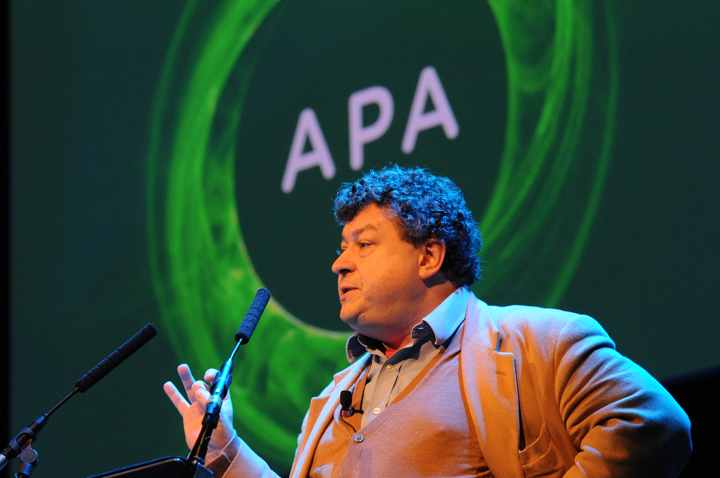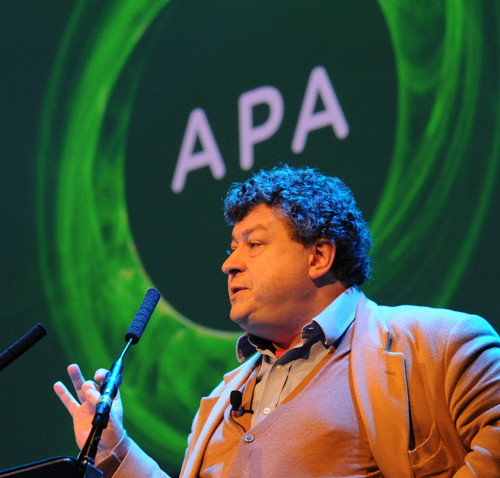The second APA International Content Summit: Content and Convergence kicked off with a metaphorical crystal ball revealing the future of content. As customers are becoming content makers in their own right the conference centred on understanding the way marketers can produce highly effective and engaging content whilst recognising the complementarity it has with user-generated content.
Daisy McAndrew, Economics Editor, ITV News and keynote speaker, Rory Sutherland, Vice President of Ogilvy, opened the summit, both acknowledging the buoyancy of the industry and its growth potential for the coming year.

Rory believes that there is clear opportunity for content providers as he thinks we have reached a period of punctuated equilibrium in the march of technological innovation. Whilst there will continue to be developments, particularly in smart TV, in general terms the next year will bring a lull affording content providers the opportunity to sit back, reflect and take stock. He urged marketers to review all the channels open to them and make them work to their full potential, explaining that he felt technical innovation has far out stripped the pace of content provision. 2012 will give marketers the chance to catch up and hence he believes we will see mass development in what goes on the technology, rather than what the technology is – hugely exciting for consumers and the industry, alike.
Session 1:
Nigel Cameron (President and CEO of C-PET and a Washington futurologist), took to the stage next to give delegates a framework to help them think about and deal with the future.
- Don’t forget Moore’s Law: everything is moving up, an exponential curve – yet it rarely frames our decisions
- Think for the long-term despite increased pressure to think short-term
- Have a trouble-maker in the team who questions everything
- Concentrate on making processes iterative
- Ask tomorrow’s questions – the question is what is the question?
Philip Thomas (CEO of Cannes Lions), third up to the stage, echoed some of Rory’s earlier sentiments, talking about how creativity will drive the future. He discussed how brand side marketers are increasingly seeking the holy grail of creativity, highlighting the correlation between winning Advertiser of The Year at Cannes and a surge in share price. Creativity is no longer a nice to have, but a key business decision. This gives content providers a world of opportunity to give creative solutions to clients particularly as the blurring of lines means that there are no hard and fast rules as to which discipline is the most creative.
Next to the stage was Richard Cope (Global Head of Insight at Mintel) giving the case for “slow” as the new premium. He gave stats on the speed of modern life and gave very real examples of how we are fundamentally changing the way we live our lives –such as Ikea’s redesign of the humble bookshelf to suit the “bookless” future. However, irrespective of the fast forward button he identified the appetite for luxuriating in the ability to do something slowly. He identified this developing trend as a key opportunity for brands in their ability to give their customers something to savour and enjoy.
Benedict Evans (Enders Analysis) finished off the session looking at how people consume content, looking at trends in web, smart phone, tablet, social media and app usage. It became clear that providers of content do not just have to think about creativity, consumer trends or indeed decision making, but also about the actual mechanics in which customers can access content. For example people today aren’t using the web in the way it was intended when it was invented and as a result it is vital to consider the route map. And then reconsider it every few months to ensure that people can find what has been developed.
Session 2:
Session two focused on how brands can make their content stand out in a world full of content producers. Richard Charkin (Executive Director of Bloomsbury Publishing), gave the case for edited content demonstrating the primary reason for “editors” – to sift through all of the dross. Consumers trust brands to provide content that is relevant to them. It is this trust that the brand has to remember, if you abuse the trust you’ll lose the customer.
Geoff Hughes (CEO and co-founder of Social Clay) went on to talk about a specific channel –Facebook, and gave a masterclass on how to blur the line between personal and commercial by making branded content suitable for a social space. Conversely to traditional printed content, the key here is making branded content look like unedited content – a Facebook page that looks like a brochure does not work. There has to be a compromise between having a brand essence and a blatant sales tool.
Finally Carla Buzasi (Huffington Post) provided a case study of successfully bringing together edited and unedited content through the blend of four disciplines: breaking news, aggregation (edited) and blogs and comments (unedited). This approach gives the Huffington Post both its brand, and also its mass appeal.
Session 3:
Session 3 concentrated on content on the go; specifically content through social media and mobile.
Charlie Osmond (Creative Director, FreshNetworks), set the scene by posing three key challenges for content providers over the next year:
- How to stop open-field sowing – throwing out content in the hopes some of it hits
- How you get real world experiences (experiential) to resonate in the world of social
- How to move away from top line “social media strategy” and following the herd to developing specific, company level social media strategy – what will you do different?
Mark Challinor (Director of Mobile at Telegraph Media Group) stepped in to answer question number three, explaining the social and mobile strategy of The Telegraph. Research revealed distinct reader groups using The Telegraph’s different channels , for example the average age of the ipad user is 51, which is older than readers of telegraph.co.uk, but younger than readers of the print edition. Audience insight is helping The Telegraph to inform its mobile and social strategy, however, what is clear is that whilst they don’t have all of the answers, involving the customer in the journey is proving crucial.
Next up was David Glennie (Chief Innovation Officer, Mobile Interactive Group), who held a mass workshop amongst delegates to define the five predominant uses of social media:
- Destination
- Viral
- Acquisition
- Care (listening)
- Comms
These are the five action points content providers need to address when creating content to be distributed through social media channels.
Summing up the third session was Kam Star (Managing Director, Playgen) who introduced the concept of Gamification and extolled its usage in the generation of content. Gamification is the art of persuasion coupled with gaming mechanisms to motivate human behaviour; a theory grounded in psychology. With the continued dominance of gaming, borrowing some of its principles to create marketing campaign seems to be a dead cert for 2012.






